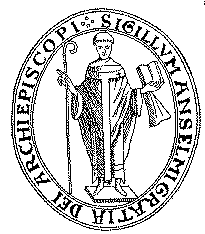William II
Before he died William the Conqueror divided his property amongst his three sons. William II (1087-1100) got England, Robert got Normandy, and Henry got money. William II was unpopular, greedy, self-centred, and a poor administrator.

When Archbishop Lanfranc died in 1089, William delayed appointing a replacement for four years, keeping the revenues of the see of Canterbury for himself. When Anselm became Archbishop in 1093 he fought with William over the powers of church and lay courts.
William II's Death
In one of those little incidents that will forever remain a historical mystery, William was killed while hunting in the New Forest, stepping in front of an arrow shot by one William Tyrrell. Evidently Tyrrell wasn't sure his claim that it was an accident would be believed, for he fled and went into hiding.
Technically, William's death left the throne to Robert, who was in Normandy. Henry, however, was on the scene and acted quickly to seize the royal treasury at Westminster and proclaim himself king of England. He later defeated Robert at Tinchebray (1106) and added Normandy to his cap as well. Poor Robert spent the rest of his life in prison.
Henry I, called Beauclerc, seems to have made a much better king than his elder brother William.

weighing money
During his reign (1100-1135) the royal administration was expanded and the rule of law solidified. The Court of the Exchequer was formed to handle financial matters. It took its name from the checkered cloth or table on which the accounts were handled.
Charters
One of the ways Henry raised money was by selling charters to towns. Charters were a special grant that enabled towns to build walls, raise local taxes and elect their own local administrators.
Monasteries
During Henry's reign, a new wave of monastic settlements began, beginning in 1128 when the Cistercians arrived from France. Many of the great monasteries, now ruined, are from this time period. One of the easiest ways of identifying buildings from this early Norman period is by the shape of their window, door, and arch openings, which are smoothly rounded.
Language
The language of the court, schools, the law, and the aristocracy was Norman French. It was not until the loss of Normandy in 1204 that the Normans began to learn English and a melding of the two languages began.
MORE Medieval Britain:
Back: William the Conqueror
Next: Stephen and Maud
Medieval Britain - from 'A History of the British Nation' (1912)
Medieval attractions in Britain (places to see tagged with 'medieval')

